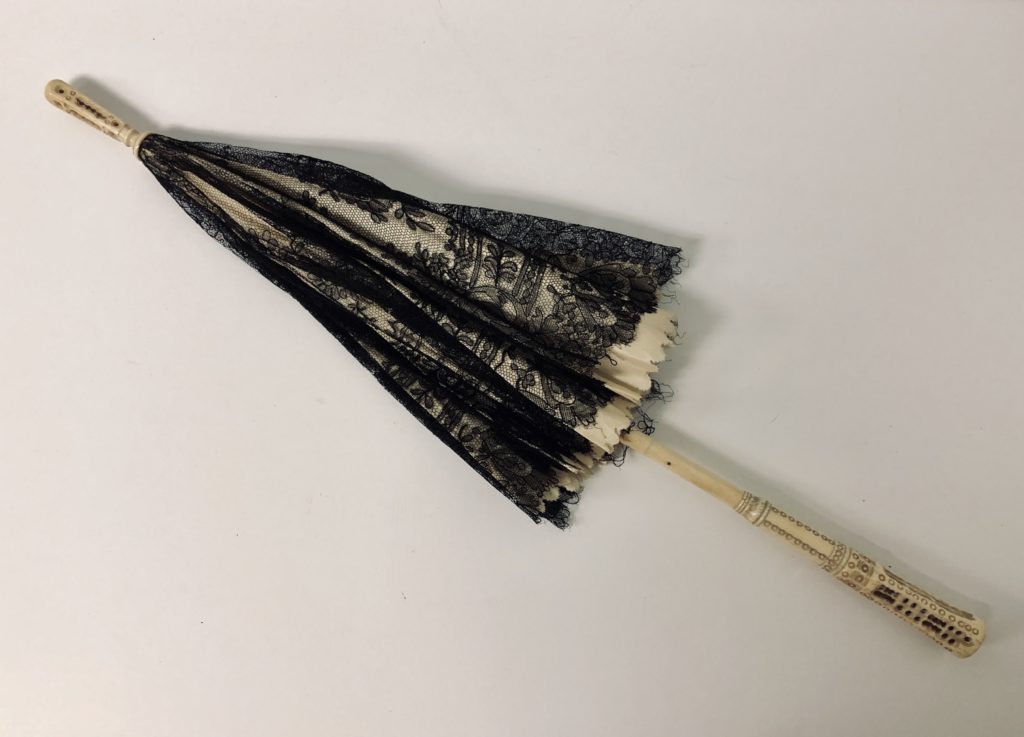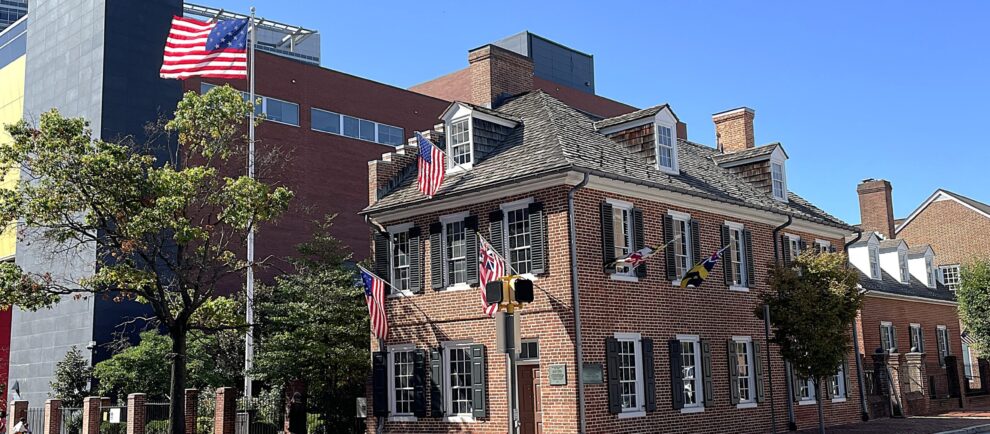
It is almost impossible to separate black clothing of the nineteenth century from the mourning customs of the Victorian period. However, black velvet, lace, and other trimmings could adorn the fancy dresses of the fashionable nineteenth-century woman. An 1802 Philadelphia publication on contemporary fashion describes a close-fitting bonnet of black velvet trimmed with black lace. A second is described as having a turned-up brim at the front, lined and trimmed with scarlet, and sporting a scarlet feather. Yet another pink silk bonnet is listed as being trimmed with black ribbon and adorned with black lace and feather. In February of 1802, a walking dress of white muslin, under a scarlet cloak trimmed all around with black lace and the matching bonnet is described in “Lady Brownlow’s Reminiscences.” When paired with pink, purple, scarlet, and blue fabrics, black was a familiar accent to walking outfits and evening attire of the early 1800s. By the winter of 1823, black satin shoes, black velvet hats, and black velvet dresses were all the rage and were often trimmed in black lace. Eleven years earlier, Napoleon sponsored the resurrection of Chantilly lace production in Normandy. At the height of its popularity during the 1830s, every fashionable lady would have had collars, veils, cuffs, and other clothing trimmed in black Chantilly lace. A revival of black Chantilly lace in the 1860s is exemplified by lace production’s role during 1862, International Exhibition. Visitors were treated to watching lace manufacturers producing an order for tunics, trimmings, pocket-handkerchief, fan, and parasol, all en suite for the sum of 150,000 francs.
In the last half of the nineteenth century, black clothing becomes synonymous with the customs and symbolism surrounding the etiquette of Victorian mourning. While black was, of course, required for deep mourning, rules of grieving also dictated the types of fabrics acceptable for this first stage of mourning. Dresses of bombazine, paramatta, delaine, barege, merino, and crape were considered appropriately somber for deep mourning. Bonnets were to be of plain black crape with a long crape veil, a shawl of plain black with no trimming or border were topped off with black crape collar, sleeves, black boots, and gloves. Black fabrics of the time also held invisible dangers. Black dyes, especially those used in the crape veils, could irritate the eyes, were harmful to breathe in, could affect the complexion, and leave staining on the skin. Ladies’ etiquette books didn’t only give instruction in the fashionable and refined art of mourning dress, they also gave practical advice for combating the effects of the dye. Even recipes for pastes to remove the staining caused by sweating in black mourning attire were given. In the 1872, “Ladies Book of Etiquette and Manual of Politeness: A Complete Handbook for the Use of the Lady in Polite Society,” by Florence Hartley, the procedure for removing skin staining required the purchase of 1/2 oz each of cream of tartar and oxalic acid, a poison, from the druggist’s who would combine and crush them together in a mortar. The lady would then dip a dampened towel into the paste and apply it to the skin, with instructions to immediately wash it off with soap and water. As the deep mourning stage ended, women could begin to substitute all-black attire with grays, deep purple, and lavenders and could begin to incorporate lace and other adornments like bows and short veils. An 1842 mourning outfit is described as a dress of black barege made with a deep hem at the bottom of the skirt and bodice cut three-quarters high and laced up the back. A ruche of the material finishes the neck of the corsage and the edge of the long tight sleeves. A pelerine of black lace cut low in the beck is worn around the shoulders and fastened with a black ribbon bow. An under-dress which shows through the barege is of grey. A drawn bonnet also of grey, trimmed round the face with black tulle, and small black flowers and long grey feather surrounds the crown and hangs down on the left side. Gloves of black lace and slippers of black completed this costume.

Half Mourning Ensembles, c. 1880 
Daguerreotype of a Young Women
c. 1845 – 1850
Star-Spangled Banner Flag House Collection, FH1930.2.2c
Gift of Ms. Nellie Williams
Daguerreotype of a Young Women
c. 1845 – 1850
Star-Spangled Banner Flag House Collection, FH1930.2.2c
Gift of Ms. Nellie Williams
Daguerreotype
1845
J.T. Williams Gallery, York, Pennsylvania
Star-Spangled Banner Flag House Collection, FH1930.2.2c
Gift of Ms. Nellie Williams
Portrait of Cecilia Dushane, age 21. Wife of John Thomas Williams and daughter of Lieutenant Valentine Dushane, who was among the first Defenders of Baltimore, 1812.

Veil
c. 1860 – 1890
Chantilly lace
Star-Spangled Banner Flag House Collection, FH1963.1.1
Gift of Miss Trisler Simmons Pentz
Duchess du Longueville opened a lace manufactory in Chantilly in the 17th century, her patronage made the hand made bobbin lace popular and by 1660 the French lace had been introduced to high fashion of the period in England. Chantilly lace has a resurgence of popularity during the reigns of Louis XV (1715-1774) and Louis XVI (1774-792) and was a special favorite of Marie Antoinette and Louis XVI’s mistress Madame du Barry. Black Chantilly lave is especially popular and was suitable for eveningwear and mourning. By 1789 and the onset of the French Revolution the demand for and production of lace ceases. Lace makers were seen as part of the aristocracy and after Marie Antoinette and Madame du Barry are sent to the guillotine in 1793, the execution of the royal lace makers quickly followed. Black lace is notoriously difficult to work with as the contrast of the thread is hard to work with and hurts the eyes. In 1844, machined bobbin lace was introduced to replicate the hand made silk lace, tons of black lace poured off looms in silk, cotton, and rayon. Very little black Chantilly lace has survived as the iron salts contained within the dye rot the delicate silk. Black lace occurred as a fashion necessity and was used to indicate mourning, matronliness, and to conceal as early as the late 16th century. It also became popular as trimmings of gowns and can be seen in portraits of Mary Queen of Scots, Madame de Mainteon, Louis the XIV’s second wife, and Queen Charlotte.
Fan
French, c. 1880 – 1890
Chantilly lace, silk, mother of pearl
Star-Spangled Banner Flag House Collection, FH1930.2.2a
Gift of Mrs. Thomas Green
Lady’s Boots
c. 1890
Black leather
Star-Spangled Banner Flag House Collection, FH1985.6.1a-b
Gift of Mrs. Dorothy Davenport
Spool heels, like the ones on these high-top leather boots, are wide at the top and bottom with a bend in toward the arch of the foot that is intended to steady the foot on the heel.
Sunshade (Parasol)
French, c. 1880
Chantilly lace, taffeta, ivory, and metal
Star-Spangled Banner Flag House Collection, FH1963.6.1
Gift of Mrs. Thomas Green
Black Chantilly lace over light-colored silk taffeta. Hollow ivory handle with carved geometric design of circles. A metal hinge allows for the parasol to be folded in half for storage and carrying.
Parasol handle detail 
Evening Pouch
American, c. 1830 – 1860
Star-Spangled Banner Flag House Collection, FH1963TSP
Gift of Miss Trisler Simmons Pentz
Knitted beadwork bags were required by etiquette for the fashionable 19th century woman. Motifs were restrained, simple, and elegant. Variations of round and beveled beads added texture and sparkle.
Full and Half Mourning Ensembles, c. 1890
